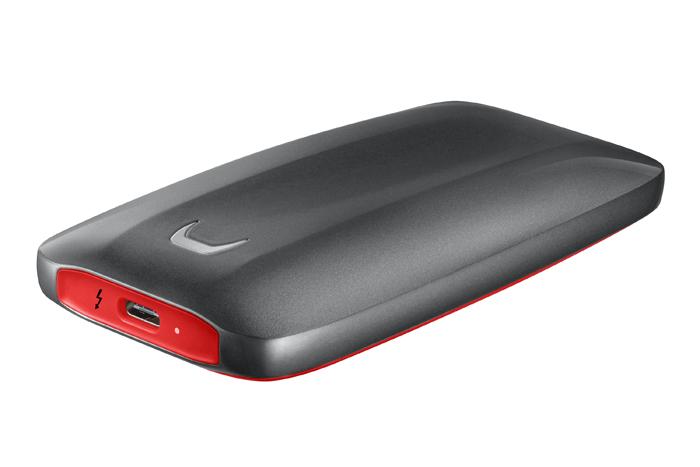Samsung’s new Thunderbolt 3 SSD sets the portable drive free from the shackles of USB
The Solid State Drive (SSD) has transformed workstation storage, delivering dramatically faster read/write speeds and generally making workstations much more responsive. It’s also enabled true multitasking by being able to read and write multiple files as the same time without the workstation grinding to a halt as the spindle of the hard disk drive’s (HDD) moves into position. But the SSD has also had a huge impact on external storage. Performance benefits aside, portable SSDs are smaller than HDDs and, because there are no moving parts, much more rugged.
Over the last few years, performance of portable SSDs has been limited by the USB interface. Even with USB 3.1, read/write speeds have peaked around 540MB/sec. But now with Thunderbolt 3, which is widely available in new generation mobile workstations, peformance of portable SSDs has gone through the roof.
The Samsung SSD X5 is one of the first portable drives to take advantage. It boasts a phenomenal read speed of up to 2,800 MB/s, which on paper is up to 5.2 times faster than portable SATA SSDs and up to 25.5 times faster than external HDDs. Write speeds have also increased, rising to 2,300MB/sec.
The pebble-shaped X5 features a full metal body with a glossy finish and non-slip bottom mat. It’s shock resistant, with Samsung claiming it can withstand accidental drops of up to two metres.
The X5 is a little bit bigger than its USB 3.1 predecessor, the Samsung SSD T5, but it’s still nice and compact. It weighs 150g and is 119 x 62 x 19.7mm in size. It comes with a 45cm Thunderbolt 3 (USB-Type C) cable.
We used a Dell Precision 5530 2-in-1 to test read/write speeds over Thunderbolt 3 with three real-world datasets from Revit, SolidWorks and 3ds Max.
The drive came formatted to exFAT so it can work on multiple operating systems, but we reformatted to NTFS as this should give more performance, particularly with small files.
In tests, we found it to be significantly faster than the Samsung SSD T5. The biggest gains came with the biggest files. For example, with 68 large Revit files, totalling 4.6GB, read performance averaged 1,153MB/sec and write performance 1,147MB/sec. This is about three times faster than the T5 (396MB/sec read and 335MB/sec write).
Our 3ds Max dataset offers more of a mix, comprising 60 large scene files and 4,400 smaller materials, totalling 4.6GB. It averaged 355GB/sec read and 419GB/sec write (compared to 246GB/sec read and 217GB/sec write on the T5).
Finally, with 8.2GB of SolidWorks data, comprising 14,000 relatively small CAD parts and assemblies, speeds averaged 142MB/sec read and 148MB/sec write (compared to the 105MB/sec read and 90MB/sec write on the T5).
The X5 is a worthy successor to the T5. It’s well-built and is significantly faster, particularly when reading/writing large files. It also boasts AES 256-bit hardware encryption so you can keep your data secure.
But it’s not cheap. The 500GB model costs £189, the 1TB model £380 and the 2TB model £759 (all Ex VAT). But if you need to move files quickly or open data directly from a portable drive, this is a small price to pay.
Price from £189
If you enjoyed this article, subscribe to our email newsletter or print / PDF magazine for FREE






